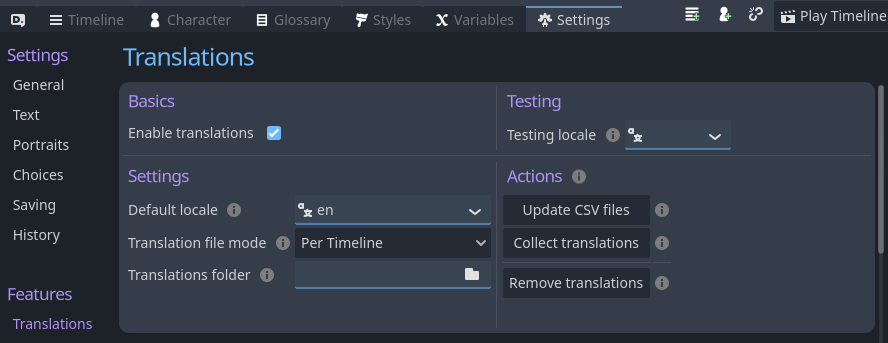This page explains how Dialogic allows you to translate timelines and other important parts of your dialogs.
📜 Content
- 1. What is a translation?
- 1.1 What can Dialogic translate?
- 2. How do I translate timelines?
- 2.5 Translating Glossaries
- 2. Testing translation
- 3. Changing the Language
1. What is a translation?
Translation is a Godot and Dialogic 2 feature, allowing you to translate your game into multiple languages.
Sometimes, the word localization is used as well.
Localization provides very specific regional considerations for each audience.
This includes not only the translation of the game, but also changes to the game itself to reflect specific cultural differences.
While Dialogic supports the translation of your timeline, it's better to focus on
your game first and add translation later.
However, keeping translation and localization in mind is an excellent idea:
- How will you handle variables?
- Do you need the glossary?
- What images do you want to localize?
- Any features in mind that may complicate translation?
1.1 What can Dialogic translate?
Dialogic can automatically translate your timelines, character names, and glossary entries.
2. How do I translate timelines?
In Dialogic, head to the Settings tab and take a look under the Translation section. Tick the "Enable Translation" checkbox.

2.1 Setting up translation
Let's walk through the settings! You will have to pick a default locale. This locale must be the language you write the timeline in. Additionally, this locale will be used as a fallback if no translation exists for a given translatable event. The "translation file mode" allows you to store all your timelines into one file (Per Project) or into multiple files (Per Timeline).
Setting up a translation folder is a good idea; it keeps your project clean and allows you to easily find your translation files.
2.2 Writing translations
First and foremost, you will need a timeline file. Dialogic will automatically find and generate CSV files for you after you hit the "Update CSV files" button.
The CSV format is simple, and you can open it with any spreadsheet software, like Excel or Google Sheets. Even VSCode offers extensions to edit the file.
The gist of CSV files is that each line represents a row, and each column is separated by a comma.
Once Dialogic has generated the CSV file, it may look like this:
keys,en
Text/1/text,Hello World!"
The keys are locales; the en is the locale code for English. If you choose a different default locale, the locale code will be different.
You can add a new language for your game by adding a new column. The following example added "ja" for Japanese to the first row and translated the text in the second row. Pay attention to the commas!
keys,en,ja
Text/1/text,Hello World!,こんにちは世界!
That's it! You can now hit "Collect translation," and Dialogic will generate a translation file for you.
The translation file is a specific Godot file. Here is their official documentation: Internationalizing games
In CSV, you use commas to separate columns. However, if you want to use commas inside your text, you will have to wrap your text in quotation marks and escape any nested quotations.
Once you generated translation, if you change the text of a translated unit (text event, character name, or glossary entry), you must generate the translation again.
2.3 The Translation workflow
From now on, whenever you change the CSV file, you can hit "Collect translation" and Dialogic will update the translation files for you.
Once you are done editing your timeline, you will have to hit "Update CSV files" to update the CSV file.
To verify whether your timeline has properly inserted your text into the CSV, you can switch to the timeline Text editor. Obviously, you can check the CSV file too.
Character: Hello world! #id:14
Do you like Visual Novels? #id:15
- Yes, I do! #id:16
- No, I love them! #id:17
That's the spirit! #id:18
The #id tags at the end of each Text Event are the translation IDs. They won't be visible during text display; however, Dialogic has inserted the text into a CSV file.
2.4 Translating Characters
Characters will be translated if they are part of a timeline. They will always get put into a per-project file. Their name and nick will be translated.
2.5 Translating Glossaries
Glossaries have a reserved property for translation: _translation_id.
They also have a reserved _translation_keys property, mapping translated words to
the translation key.
These properties get automatically populated via the "Update CSV files" button.
Entries prefixed with _ (underscore) are considered private and will be ignored. Every other String property will be translated and put into the CSV.
The name and alternatives of a glossary entry must be unique, the same applies for the translated counterparts.
Otherwise, resolving the correct entry will be impossible.
Glossary names or alternatives may not start with Glossary/.
Once translation has been enabled, and you are testing another locale, glossaries won't fall back to the default locale when an entry property has not been translated.
2. Testing translation
If everything went well, you can select a different locale in the "Testing locale" dropdown.
Hit "Play Timeline" or "Run Project" and take a look at the translated text.
This setting is editor-only and may not work in exported projects.
3. Changing the Language
The translation process is handled by Godot!
To change the locale when your game is exported, use the Godot API method on the TranslationServer class:
# Japanese's language code is "ja"
TranslationServer.set_locale("ja")